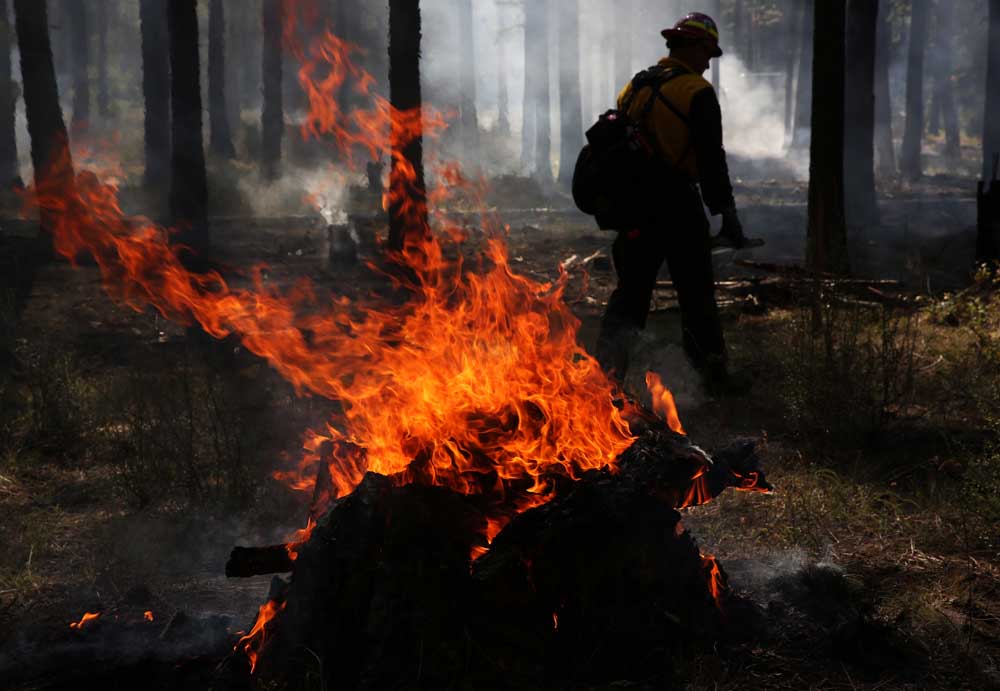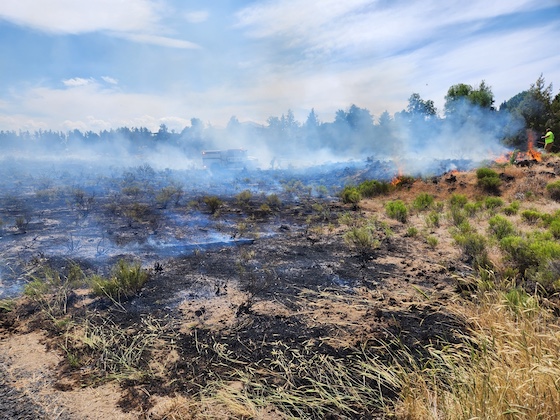Redmond Airport: City’s largest landholder
Published 6:00 am Thursday, September 16, 2021

- Travelers deplane at the Redmond Municipal Airport on June 8.
At 2,518 acres, the Redmond Municipal Airport (RDM) — aka Roberts Field — is a little more than double the entire area of the city of Sisters and 32% larger than Eagle Crest subdivision. When added with the air traffic at Bend Municipal Airport (BND), the two make for the busiest air traffic in all of Oregon, more than Portland International (PDX), airport officials say.
We tend to think of RDM as where we go to go. Visits to family and the starting point for vacations, conferences, meetings or conventions and the landing place for thousands of visitors to our Central Oregon playground. Prior to the pandemic, just over 1 million passengers arrived or departed at RDM in 2019 on six carriers serving 11 non-stop destinations. In other words: a busy place that we probably take for granted unless you happen to be on the glide path for arrivals contending with noise.
RDM’s real estate vastly outsizes its needs to handle passengers. Zachary Bass, Airport Director, said recently: “My job is about 20% aviation and 80% being a landlord.” Indeed, Bass has 143 tenants on the irregular shaped property. They range from governmental to commercial.
A major tenant is the Air Tanker Base operated by the US Forest Service. The base is a front line offense against wildfire in a multi-state region and a hectic scene of activity during fire season.
Firefighting base, private firms
Aerial firefighting is big business at RDM using and other aerial resources. Aircraft types used include fixed-wing aircraft and helicopters. Smokejumpers and rappelers are also classified as aerial firefighters, delivered to the fire by parachute from a variety of fixed-wing aircraft, or rappelling from helicopters. Chemicals used to fight fires include water, water enhancers such as foams and gels, and specially formulated phosphorous fire retardants.
As would be expected, the larger tenants at RDM are in the aviation field. Leading Edge Jet Center does aircraft maintenance and repair, storage, and fueling including SAF (Sustainable Aircraft Fuel) a bio-diesel grade for jets that they produce and distribute.
Founded in 1980 with a single helicopter, Hillsboro Aero Academy at RDM has grown to become one of the largest multi-campus helicopter and airplane flight schools in the United States. Hillsboro trains for all levels of commercial aviation and is part of a pilot feeder course for United Airlines.
Caterers, fueling services, repair shops, car rental agencies, parking and concession holders round out the mix of support businesses needed to keep RDM flying.
Largest land parcel in the city
Roberts Field is the largest land parcel in Redmond. It is a full 25% of Redmond’s total land size. Over the years a series of land trades, sales and acquisitions shape it today. Its boundary touches the Fairgrounds, land portions RDM once owned. Central Oregon Community College sits on land once under control of Redmond Airport.
Further suggesting the scale of the land based side of RDM are the ten unneeded parcels for commercial development. They range from 2.1 acres to 35.3 acres.
Bass says people often ask about the name — Roberts Field. Most think the airport which was a U.S. Army Airforce bomber base in World War II, was named for a military figure. The airport is actually named for J. Roy Roberts who arrived in Redmond on the first train in 1911. He partnered with M.A. Lynch and they formed a successful Redmond mercantile in 1917 bearing their name.
Roberts served as Redmond’s mayor from 1918 to 1921 and again between 1932 and 1935. He was a visionary chiefly responsible for the development of the Redmond Airport.
RDM is in a constant state of construction it seems. Passenger flights arrived in 1940. The original terminal built in 1950 was replaced in 1981 by a 6,000 square-foot structure. In a dozen short years, the terminal grew to 23,000 square feet.
Runway improvements
Knife River has just been awarded a $6.5 million contract to improve taxiway F in a continuing series of projects meant to meet growing numbers of passengers and larger fleets. And despite Covid-19’s heavy impact on air travel, Bass says the airport is looking at a $150 million terminal area concept plan to meet future demands.
“We need a larger hold room, where people wait for their flights,” Bass said. “We’d like to see jet bridges, especially with Central Oregon weather to replace outdoor boarding.”
The plan would expand the terminal to the west accommodating future passenger demand and larger aircraft. RDM is hoping to lure a carrier to provide non-stop service to Dallas with an $800,000 incentive grant from the US Department of Transportation awarded in late July.
Some flights ending
Short term, Bass reports that after eight straight months of passenger growth following pandemic lows, recent days show a dropping off and he expects a decline for September and possibly the remainder of the year until the Delta variant surge subsides.
In a further show of the market softening, Bass hints that Alaska will discontinue flights to and from Portland. Boutique Air gave up RDM – PDX service in August after failing to generate adequate traffic. Allegiant is soon dropping Redmond to Phoenix (Mesa) service, but Alaska and American plan to maintain their daily non-stop flights to Phoenix (Sky Harbor) which are popular for snowbirds wintering in Arizona.
Most think the airport, which was a U.S. Army Airforce bomber base in World War II, was named for a military figure. The airport is actually named for J. Roy Roberts who arrived in Redmond on the first train in 1911. He partnered with M.A. Lynch and they formed a successful Redmond mercantile in 1917 bearing their name.
Roberts served as Redmond’s mayor from 1918 to 1921 and again between 1932 and 1935. He was a visionary chiefly responsible for the development of the Redmond Airport.









